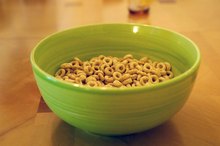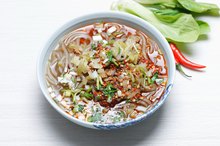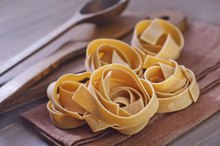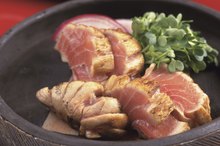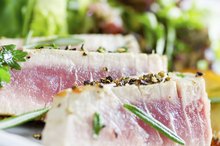What does fact checked mean?
At Healthfully, we strive to deliver objective content that is accurate and up-to-date. Our team periodically reviews articles in order to ensure content quality. The sources cited below consist of evidence from peer-reviewed journals, prominent medical organizations, academic associations, and government data.
The information contained on this site is for informational purposes only, and should not be used as a substitute for the advice of a professional health care provider. Please check with the appropriate physician regarding health questions and concerns. Although we strive to deliver accurate and up-to-date information, no guarantee to that effect is made.
Foods to Eliminate If Allergic to Niacin
Niacin also is known as vitamin B3, a vitamin necessary to build fatty acids and red blood cells and convert carbohydrates, fats and proteins into energy. While niacin has important functions, it is possible to be allergic to foods that contain it 1. When you experience an allergic reaction to niacin, your body treats it like a foreign invader, resulting in inflammatory symptoms like a rash, breathing difficulty or itching skin. While the foods listed below do not make up a comprehensive list of niacin-containing foods, they are a representative sample of foods to avoid.
Meats
A variety of meat sources have niacin. One example is light-meat turkey, which contains 6 mg of niacin per 3-oz. serving. The same serving size of cooked lean ground beef contains 5 mg of niacin per serving 1. Fish like salmon also have 7 mg of niacin per 3-oz. serving.
- A variety of meat sources have niacin.
- Fish like salmon also have 7 mg of niacin per 3-oz.
Tryptophan-Containing Foods
Does Niacin Help With Weight Loss?
Learn More
When you take in foods containing tryptophan, your body converts the trytophan into niacin, meaning they could cause you to have an allergic reaction. These foods can have sleep-inducing effects on your body -- one example is the Thanksgiving turkey that makes you feel sleepy after eating. Other tryptophan-containing foods include red meat, eggs and dairy products.
Fortified Foods
Certain foods are fortified, or have vitamins and minerals added to them, to increase their nutritional value. Niacin is an example of a vitamin often added to fortified foods 23. Examples include ready-to-eat cereals -- 1 c of cereal contains about 5 mg of niacin 2. Whole-grain breads also may have niacin added to them -- you may wish to purchase non-enriched or refined-grain breads to avoid niacin.
- Certain foods are fortified, or have vitamins and minerals added to them, to increase their nutritional value.
- Whole-grain breads also may have niacin added to them -- you may wish to purchase non-enriched or refined-grain breads to avoid niacin.
Additional Sources
Allergy to Niacin
Learn More
Other dietary sources of niacin include organic peanuts or peanut butter, which contains about 3.8 mg of niacin per 3-oz. serving. Potatoes also contain niacin -- one medium potato has 2.7 mg per serving. One cup of cooked lentils contains 2.1 mg of niacin, while the same size serving of lima beans has 1.8 mg. Sunflower seeds, beets, brewer’s yeast and mushrooms also contain niacin.
- Other dietary sources of niacin include organic peanuts or peanut butter, which contains about 3.8 mg of niacin per 3-oz.
Considerations
Niacin can be difficult to avoid in your daily diet because many foods contain it 1. However, your physician may recommend eating foods known to contain small amounts of niacin, which may be less likely to cause an allergic reaction in your body. Determining how much niacin you can consume without causing a reaction in your body is an individual process. Some people with a niacin allergy may be able to eat 3 mg at a time while others may not tolerate niacin at all. Work with your physician and keep a food journal recording any reaction you may have to determine your individual tolerance level. Note that excess niacin intake can cause symptoms similar to an allergic reaction, including skin flushing, stomach redness and warmth, particularly of the face. Your physician may recommend allergy testing to determine if you have an allergy or symptoms of excess intake.
- Niacin can be difficult to avoid in your daily diet because many foods contain it 1.
- Note that excess niacin intake can cause symptoms similar to an allergic reaction, including skin flushing, stomach redness and warmth, particularly of the face.
Related Articles
References
- DrBenKim.com; Healthy Foods That Contain Niacin; Dr. Ben Kim; January 2005
- University of Florida IFAS Extension; Facts About Niacin; R. Elaine Turner and Wendy Dahl; Mary 2010
- University of Maryland Medical Center; Vitamin B3 (Niacin); 2011
- MedlinePlus; Allergic Reactions; May 2010
- National Institutes of Medicine Office of Dietary Supplements. Niacin Fact Sheet for Health Professionals. Updated June 3, 2020.
- MedlinePlus. Niacin. Updated June 4, 2020.
- Boden WE, Probstfield JL, Anderson T, et al. Niacin in Patients with Low HDL Cholesterol Levels Receiving Intensive Statin Therapy. N Engl J Med. 2011;365(24):2255-2267. doi:10.1056/NEJMoa1107579
- Morris MC, Evans DA, Bienias JL, et al. Dietary niacin and the risk of incident Alzheimer's disease and of cognitive decline. J Neurol Neurosurg Psychiatry. 2004;75(8):1093-1099. doi:10.1136/jnnp.2003.025858
- Elam MB, Hunninghake DB, Davis KB, et al. Effect of Niacin on Lipid and Lipoprotein Levels and Glycemic Control in Patients With Diabetes and Peripheral Arterial Disease: The ADMIT Study: A Randomized Trial. JAMA. 2000;284(10):1263-1270. doi:10.1001/jama.284.10.1263
- Zhai G. Alteration of Metabolic Pathways in Osteoarthritis. Metabolites. 2019;9(1):11. doi:10.3390/metabo9010011
Writer Bio
Rachel Nall began writing in 2003. She is a former managing editor for custom health publications, including physician journals. She has written for The Associated Press and "Jezebel," "Charleston," "Chatter" and "Reach" magazines. Nall is currently pursuing her Bachelor of Science in Nursing at the University of Tennessee.
